When in Townsville, a stroll along The Strand is a must. A walkway starts at historic Jezzine Barracks and ends at the current ferry terminal. The path follows the line of the beach past swimming enclosures and coffee outlets. After the Water Park and Tobruk Pool, where Dawn Fraser, Murray Rose and other great swimmers once trained for Olympics, you reach ANZAC Park. ANZAC Park is a wide stretch of manicured lawn with large shady trees. It is a place of remembrance. There is a cenotaph, an eternal flame and dedications to those who served. The civilian’s contribution to war is recognised and Victoria Cross recipients have individual plaques. Later on you pass a monument to the battle of the Coral Sea before reaching a Memorial Wall for ex- service Men and Women. This south end of The Strand is a place of remembrance and reflection. But many people don’t know that during WW2, the site was a bustling navy base named HMAS Magnetic – a large establishment with 500 personnel and 50 buildings.

The Townsville Cenotaph commemorates those who have served in the various conflicts in which Australia has been
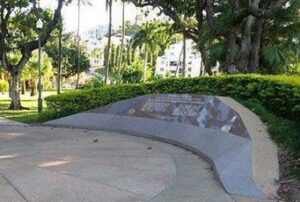
The Strand, ANZAC Park, Townsville memorial – The Battle of The Coral Sea
The Maritime Museum of Townsville believes that this little-known wartime contribution should be remembered. The Minister for Veterans’ Affairs has awarded a grant under the “Saluting their Service” program to the Museum to erect a plaque in ANZAC Park at the approximate location of HMAS Magnetic. An unveiling ceremony of the plaque occurred on 10 October 2023. The Mayor, Cr Jenny Hill AM, and the local member for Herbert, the Honourable Phillip Thompson, OAM, MP, officiated
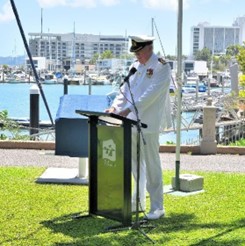
Unveiling ceremony for the HMAS Magnetic plaque 10 October 2023.
Commander Chris Kerr RFD RAN, delivering his speech outlining the dire situation Australia was facing in the early 1940’s.
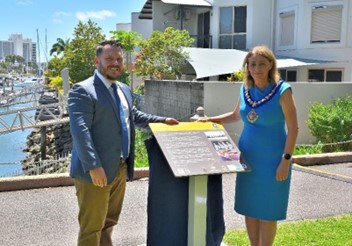
Unveiling ceremony for the HMAS Magnetic plaque 10 October 2023.
Phillip Thompson OAM, MP, Shadow Assistant Defence Minister and Federal Member for Herbert with Cr, Jenny Hill AM, Mayor City of Townsville.
Today, it is hard to comprehend the impact that WW2 had on Townsville. At the outbreak of the war with Japan, the threat of invasion and disruption of sea traffic routes to Australia was real. Townsville’s location in northern Australia was critical to the defence of the nation. The population of the city rose from 30,000 to 90,000 with the influx of service personnel from Australia and US – turning Townsville into a stronghold. Townsville was also a staging point for Australian and US personnel and the port accommodated many supply and troop ships heading north during the New Guinea campaign. Townsville became a garrison city, a title it still celebrates today.
HMAS Magnetic
HMAS Magnetic played a significant role, including communications, port examination services, a transit and repair facility for Allied warships and defence of the port. Commissioned in September 1942, HMAS Magnetic was located on The Strand with its entrance opposite todays Criterion Hotel. Through the entrance were many buildings for various uses including administration, stores, workshops, accommodation and a supply/refuelling jetty along Ross Creek. However, HMAS Magnetics footprint extended beyond the base with outstations located on Magnetic Island, in the port itself and a communications post on Castle Hill.
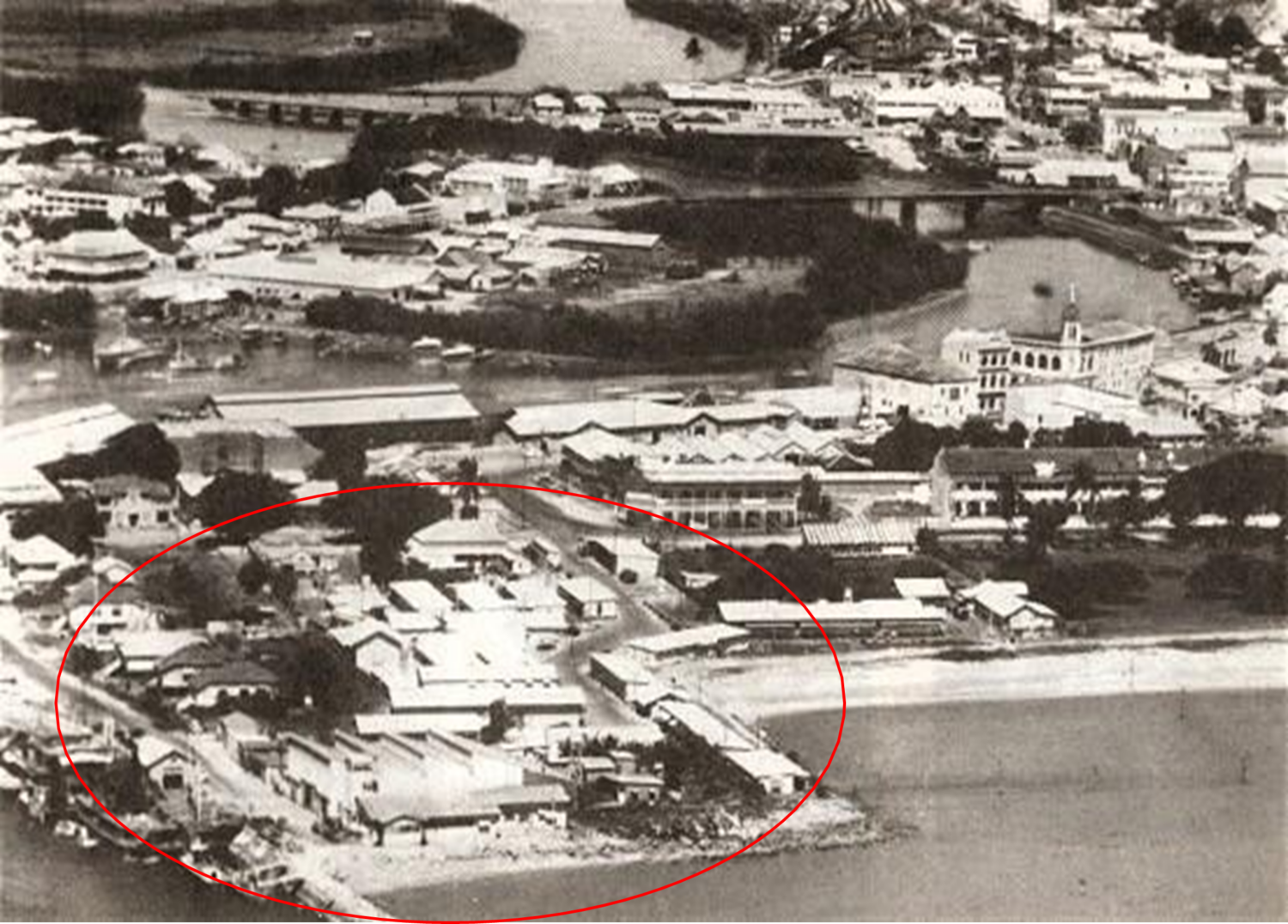
Aerial view of HMAS Magnetic Circa 1945
The diverse naval activities of HMAS Magnetic fell under the command of the Naval Officer in Charge (NOIC) Townsville. The NOIC’s Naval Headquarters were located at 42 Sturt Street, Townsville, part of ACH (Area Combined Headquarters) established in January 1941. A section of the building was reserved for the NOIC and other Naval Staff officers. An intelligence code room and Naval Control Services were also located there. Eric Feldt was NOIC for a period and ran the Coastwatcher network from the building. Feldt was a retired RAN intelligence officer with many years of experience in the New Guinea public service. He set up the Coastwatchers network in the late 1930’s. The Coastwatchers organisation was formalised in 1939 with Feldt in charge. In early 1941, as enemy forces advanced, Feldt and his Coastwatcher responsibilities were transferred from Port Moresby to Townsville. The operation was housed at the ACH for a period using an AWA radio tower in South Townsville to maintain contact with operatives in the field. When Port Moresby was clear of enemy invasion in November 1942, Coastwatcher Headquarters transferred back to Port Moresby. Feldt resigned his command in 1943 due to illness.
There were actually two HMAS Magnetics – the base and a ship. The vessel undertook inspection and escort activities. She was 43 feet 3 inches in length and built in Sydney in 1926. She started life as “MV Pagrus” and operated for many years as a work boat for the Papuan Oil Development Company in Port Moresby. She was brought to Townsville by locals who intended to use her as a fishing charter boat but “MV Pagrus” was requisitioned by the Navy and renamed “HMAS Magnetic”. Townsville was a very busy port. Arriving vessels had to be cleared into the anchorage in Cleveland Bay before proceeding to the port. A Port War Signal Station (PWSS) was located in the forts on Magnetic Island to ensure that approaching vessels were friendly. Details of arriving vessels were sent by radio to a second PWSS located at the port. “HMAS Magnetic” was part of this process by examining and escorting ships to verify their credentials. Townsville port remained busy during 1942 and 1943. It handled over one million tons of war materials including 5,500 vehicles and 70,000 tons of oil and petroleum products. At one time there were 18 ships alongside in the port with another 64 in the Cleveland Bay anchorage. Personnel from HMAS Magnetic were very much involved in the movement of war material and service personnel. But port management remained with the Harbour Board. General Blamey appointed the local manager of Burns Philp to be Port Controller.
HMAS Magnetic had responsibility for the defence of the Port. A dedicated Section controlled the floating minefield located near the Port entrance to deter attack by enemy midget submarines. Although the establishment of the WRANS was only formalised in April 1941, by late 1942 there was a significant presence of women service personnel attached to HMAS Magnetic. Those that worked at the main base were accommodated in a purpose-built residence further back up The Strand. The WRANS would march each day to the base. 4 WRANS were also attached to Section “Y” Wireless Signal Station. This was a secret facility where WRAN telegraphists intercepted and recorded messages transmitted from enemy ships. The WRANS would record the intercepts and transpose the messages into Japanese Katakana, a phonetic script. The results were then sent onto FRUMEL (Fleet Radio Unit Melbourne) for decoding and analysis.
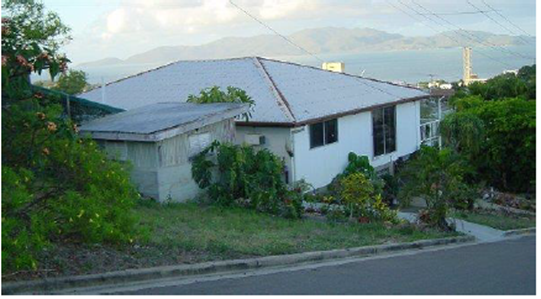
“Aileen’s Place”, 7 Hillside Crescent was the “Y” Station. ClevelandBay and Magnetic Island can be seen in the background
WRANS became familiar with the sending styles of Japanese operators and gave them nicknames. They monitored two channels at a time with their each of their two earpieces tuned to separate frequencies. The area scanned covered Guam, Yap, Wake, Guadalcanal, Manus, Trobriand and Andaman Islands- a huge area.
HMAS Magnetic closed in July 1946.
The Maritime Museum of Townsville intends to have a permanent exhibition at the Museum in addition to the plaque in ANZAC Park. There is a great story to be told and the exhibition will contain much more detail than the limited information on the plaque. The Museum is hoping that once more is known, people with a connection through family and friends who served there might come forward with memorabilia or other material to go in the exhibition.
The Museum would certainly like to hear from anyone who has any link with either the base or the vessel HMAS Magnetic.
Further Reading
- Sea Power Centre Australia, HMAS Magnetic History, available at: https://www.navy.gov.au/history/base-histories/hmas-magnetic-history
- Ozatwar, Townsville Harbour During WWII, available at, https://www.ozatwar.com/ozatwar/tvharbour.htm




